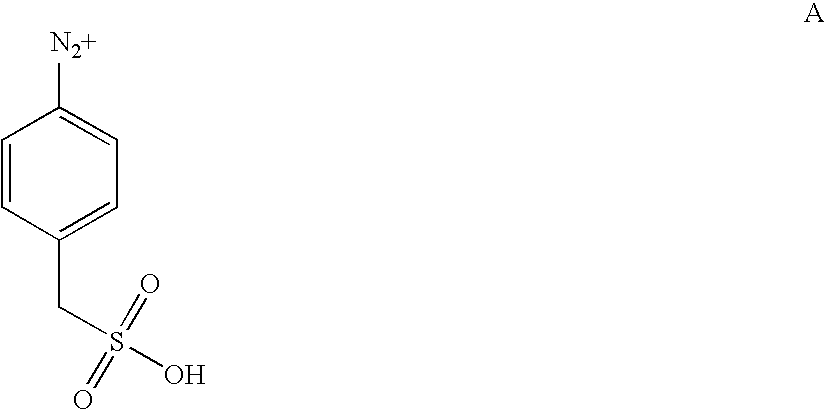Method of separating metallic and semiconducting carbon nanotubes from a mixture of same
- Summary
- Abstract
- Description
- Claims
- Application Information
AI Technical Summary
Benefits of technology
Problems solved by technology
Method used
Image
Examples
example
A. Preparation of Hydroxamic Acid Aryidiazonium Chloride:
[0063]Oxalyl chloride (10.16 g, 0.08 mole) was added to a solution of 4-nitrobenzoic acid (6.68 g, 0.04 mole) in 100 mL of anhydrous dichloromethane. A drop of N,N-dimethylformamide was added and the mixture was stirred under nitrogen for 3 hours. The solvent and excess oxalyl chloride was evaporated under reduced pressure. The residual oily compound was redissolved in 20 mL of anhydrous methanol and added to a solution of o-benzylhydroxylamine hydrochloride (0.04 mole) and triethylamine (0.08 mole) in 50 mL of anhydrous dichloromethane. The mixture was stirred at room temperature for 4 hours and then washed with dilute hydrochloric acid and brine, dried over anhydrous magnesium sulfate and filtered. Evaporation of the solvent gave light brown solid of the formula:
para-+N2—C6H4—(CH2)nCONHOH Cl−
[0064]The isolated brown solid was crystallized from ethanol to produce O-benzyl-4-nitrophenylhydroxamic acid as white crystals. Pallad...
PUM
| Property | Measurement | Unit |
|---|---|---|
| Temperature | aaaaa | aaaaa |
| Temperature | aaaaa | aaaaa |
| Fraction | aaaaa | aaaaa |
Abstract
Description
Claims
Application Information
 Login to View More
Login to View More - R&D
- Intellectual Property
- Life Sciences
- Materials
- Tech Scout
- Unparalleled Data Quality
- Higher Quality Content
- 60% Fewer Hallucinations
Browse by: Latest US Patents, China's latest patents, Technical Efficacy Thesaurus, Application Domain, Technology Topic, Popular Technical Reports.
© 2025 PatSnap. All rights reserved.Legal|Privacy policy|Modern Slavery Act Transparency Statement|Sitemap|About US| Contact US: help@patsnap.com



